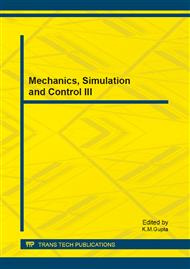p.161
p.165
p.171
p.181
p.188
p.194
p.199
p.204
p.211
Performance Comparison between PID Controller and State-Feedback Controller with Integral Action in Position Control of DC Motor
Abstract:
This paper presents the design of PID controller and State-Feedback controller with integral action to control the position of DC motor.PID controller is tuned using Ziegler-Nichol’s rules. State-Feedback controller is designed by determining the state feedback gain matrix using Ackermann’s formula. The aim of this paper is to compare the time domain characteristics of system response between PID controller and State feedback Controller with integral action. The Simulation results are demonstrated using MATLAB.Graphical User Interface (GUI) is developed for both the controllers. According to the Simulation result, State-Feedback controller with integral action has the better performance in terms of peak overshoot and settling time as compared to PID controller.
Info:
Periodical:
Pages:
188-193
Citation:
Online since:
August 2013
Authors:
Price:
Сopyright:
© 2013 Trans Tech Publications Ltd. All Rights Reserved
Share:
Citation:


